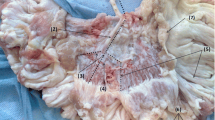Summary
-
1.
The effects of four different α-adrenoceptor antagonists (prazosin, phentolamine, yohimbine, and nipradilol) on the electrical and mechanical responses of smooth muscle cells of the dog isolated mesenteric vein to perivascular nerve stimulation and exogenous noradrenaline were investigated.
-
2.
Perivascular nerve stimulation generated an excitatory junction potential (e.j.p.), a spike potential and a slow depolarization. The latter component was blocked by yohimbine or phentolamine at doses over 10−7 M, while the former two components were suppressed by 10−6–10−5 M yohimbine, but not by prazosin, nipradilol or phentolamine (up to 10−5 M).
-
3.
Nerve-mediated muscle contractions were suppressed by these α-adrenoceptor antagonists in a concentration-dependent manner, at doses over 10−7 M. The order of potency was yohimbine > nipradilol = phentolamine > prazosin.
-
4.
Exogenously applied noradrenaline (10−6 M) depolarized the smooth muscle membrane and generated slow waves. The slow waves were blocked by all of these α-adrenoceptor antagonists (10−5 M), while the depolarizations were inhibited by yohimbine (>10−7 M) or phentolamine (10−5 M), but not by nipradilol or prazosin (up to 10−5 M).
-
5.
Contrictions produced by exogenously applied noradrenaline (10−6 M) were inhibited by the α-adrenoceptor antagonists; yohimbine or phentolamine (10−6–10−5 M) showed complete inhibition and prazosin or nipradilol (up to 10−5 M) partial inhibition. Contractions produced by high-potassium or current-stimulation were suppressed by high-concentrations (10−6–10−5 M) of these α-adrenoceptor antagonists.
-
6.
These observations indicate that the smooth muscle of the dog mesenteric vein possesses mainly α2-adrenoceptors, and stimulation of these receptors produces membrane depolarization and muscle contraction. High-concentrations of α-adrenoceptor antagonists have inhibitory effects on the muscle contraction by blocking α-adrenoceptors and also by other mechanisms.
Similar content being viewed by others
References
Asada H, Nanjo T, Itoh T, Suzuki H, Kuriyama H (1982) Effects of 3,4-dihydro-8(2-hydroxy-3-isopropyl-aminopropoxy)-3-nitroxy-2H-1-benzopyram, K-351, on smooth muscle cells and neuromuscular transmission in guinea pig vascular tissues. J Pharmacol Exp Ther 223:560–573
Bevan JA, Bevan RD, Duckles SP (1980) Adrenergic regulation of vascular smooth muscle. In: Bohr D, Somlyo A, Sparks H (eds) Handbook of physiology, sec. III, vol 2. American Physiological Sciety, Bethesda, MD, pp 515–566
Burnstock G (1981) Purinergic receptor. Receptors and recognition B12. Chapman and Hall, London
Burnstock G, Holman ME, Kuriyama H (1964) Facilitation of transmission from autonomic nerve to smooth muscle of guinea-pig vas deferens. J Physiol 172:31–49
Hirst GDS, Neild TO (1980a) Evidence for two populations of excitatory receptors for noradrenaline on arteriolar smooth muscle. Nature (Lond) 283:767–768
Hirst GDS, Neild TO (1980b) Noradrenergic transmission. Nature (Lond) 288:301–302
Hirst GDS, Neild TO, Silverberg GD (1982) Noradrenaline receptors on the rat basilar artery. J Physiol 328:351–360
Holman ME, Surprenant AM (1980) An electrophysiological analysis of the effects of noradrenaline and α-receptor antagonists on neuromuscular transmission in mammalian muscular arteries. Br J Pharmacol 71:651–661
Itoh T, Furukawa K, Kajiwara M, Kitamura K, Suzuki H, Ito Y, Kuriyama H (1981) Effects of 2-nicotinamidoethyl nitrate on smooth muscle cells and on adrenergic transmission in the guinea-pig and porcine mesenteric arteries. J Pharmacol Exp Ther 218:260–270
Itoh T, Kitamura K, Kuriyama H (1983a) Roles of extrajunctional receptors in the response of guinea-pig mesenteric and rat tail arteries to adrenergic nerves. J Physiol 345:409–422
Itoh T, Kuriyama H, Suzuki H (1983b) Differences and similarities in noradrenaline- and caffeine-induced mechanical responses in the rabbit mesenteric artery. J Physiol 337:609–629
Itoh T, Kuriyama H, Ueno H (1983c) Mechanisms of the nitroglycerine-induced vasodilation in vascular smooth muscles of the rabbit and pig. J Physiol 343:233–252
Keatinge WR (1966) Electrical and mechanical response of arteries to stimulation of sympathetic nerves. J Physiol 185:701–715
Kou K, Suzuki H (1983) The effects of 3,4-dihydro-8-(2-hydroxy-3-isopropyl-aminopropoxy)-3-nitroxy-2H-1-benzopyran (K-351) and its denitrate derivative on smooth muscle cells of the dog coronary artery. Br J Pharmacol 79:285–295
Kou K, Kuriyama H, Suzuki H (1982) Effects of 3,4-dihydro-8-(2-hydroxy-3-isopropyl aminopropoxy)-3-nitroxy-2H-1-benzopyran, K-351, on smooth muscle cells and neuromuscular transmission in the canine mesenteric artery. Br J Pharmacol 77:679–689
Kuriyama H, Makita Y (1983) Modulation of noradrenaline transmission in the guinea-pig mesenteric artery: An electrophysiological study. J Physiol 335:609–627
Kuriyama H, Ito Y, Suzuki H, Kitamura K, Itoh T (1982) Factors modifying contraction-relaxation cycle in vascular smooth muscles. Am J Physiol 243:H641-H662
Langer SZ (1977) Presynaptic receptors and their role in the regulation of transmitter release. Br J Pharmacol 60:481–497
Sneddon P, Westfall DP, Fedan JS (1982) Cotransmitters in the motor nerves of the guinea pig vas deferens: Electrophysiological evidence. Science 218:693–695
Starke K (1977) Regulation of noradrenaline release by presynaptic receptor systems. Rev Physiol Biochem Pharmacol 77:1–124
Suzuki H (1981) Effects of endogenous and exogenous noradrenaline on the smooth muscle of guinea-pig mesenteric vein. J Physiol 321:495–512
Suzuki H (1983) An electrophysiological study of excitatory neuromuscular transmission in the guinea-pig main pulmonary artery. J Physiol 336:47–59
Suzuki H, Fujiwara S (1982) Neurogenic electrical responses of single smooth muscle cells of the dog middle cerebral artery. Circ Res 51:751–759
Suzuki H, Kou K (1983) Electrical components contributing to the nerve-mediated contractions in the smooth muscles of the rabbit ear artery. Jpn J Physiol 33:745–758
Suzuki H, Mishima S, Miyahara H (1983) Noradrenaline and cotransmitters in the motor nerves of the rabbit ear artery: An electrophysiological study. Experientia (submitted)
Vanhoutte PM, Verbeuren TJ, Webb RC (1981) Local modulation of adrenergic neuroeffector interaction in the blood vessel wall. Physiol Rev 61:151–247
Author information
Authors and Affiliations
Rights and permissions
About this article
Cite this article
Kou, K., Ibengwe, J. & Suzuki, H. Effects of alpha-adrenoceptor antagonists on electrical and mechanical responses of the isolated dog mesenteric vein to perivascular nerve stimulation and exogenous noradrenaline. Naunyn-Schmiedeberg's Arch. Pharmacol. 326, 7–13 (1984). https://doi.org/10.1007/BF00518772
Received:
Accepted:
Issue Date:
DOI: https://doi.org/10.1007/BF00518772



